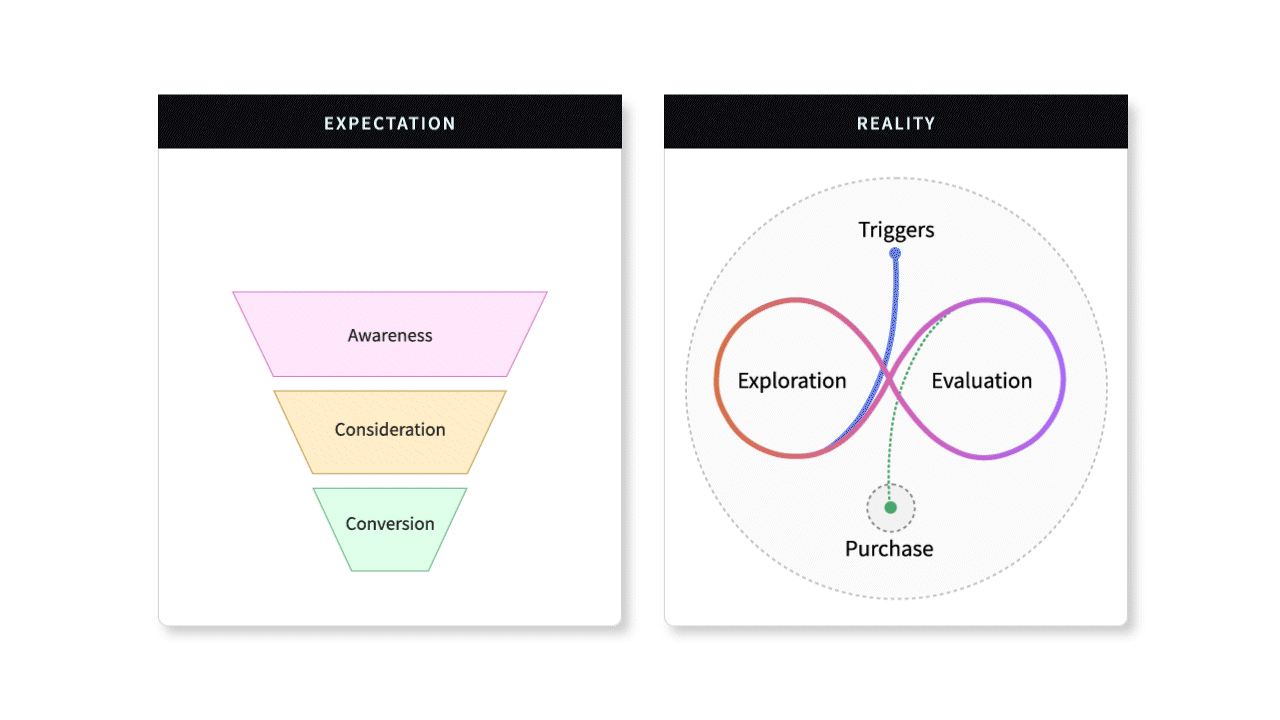
The marketing funnel has been advertisers’ go-to model for decades—we've planned around it, measured against it, and organized strategies into neat awareness-to-conversion paths. But it doesn’t accurately reflect how consumers behave.
In today's complex digital landscape, people don't make decisions in predictable linear paths. They jump between channels, loop back through consideration phases, and make purchase decisions that defy our carefully constructed funnel framework. It's time our media plans caught up with this reality.
The outdated idea that consumers move step by step from awareness to consideration to conversion still shapes many advertisers’ media plans. It drives decisions around channel selection and budget allocation, with rigid role assignments: CTV and display for awareness, native and video for consideration, search and retargeting for conversion, and so on. But in reality, consumer journeys have fractured into unpredictable, nonlinear patterns across an expanding network of touchpoints.

The images above illustrate this evolution. On the left is the traditional funnel, and on the right is what Google calls “the messy middle” —a more accurate representation of how people make decisions today.
Google’s “messy middle” research reframes the customer journey as two mental modes: exploration, when consumers are discovering options, and evaluation, when they’re narrowing them down. They loop repeatedly between these two states, across countless touchpoints, until something triggers a purchase.
Other models, like the Hankins Hexagon, express the same idea: There are very few fixed pathways, and most are two-way, with constant feedback loops and changes of mind. For example, a shopper might see a smartwatch in an influencer’s Instagram post (discovery), read reviews of different smartwatches on Reddit (evaluation), notice another option in a display ad while reading the news (discovery), and then purchase one on Amazon after spotting a promotion.
This shift should transform how advertisers craft media strategies. We can no longer think of the customer journey as a rigid sequence of awareness first, then consideration, then conversion. Instead, we should develop media plans that align with the nonlinear paths people take as they explore, evaluate, and purchase.
Awareness, consideration, and conversion are still useful metrics—we don’t need to abandon them. However, they should measure the expected impact of a touchpoint rather than dictate its role. For example, when we use TikTok strategically, we expect it to drive consideration that leads to sales, because that’s what consumer behavior and media outcomes show. While social media has traditionally been seen as an “awareness” channel, we don’t let the funnel dictate TikTok’s purpose when real-world results tell a different story. Similarly, CTV is often slotted into the awareness stage, but we’ve seen it play a decisive role in driving conversions when paired with precise audience targeting and sequential messaging.
Instead of forcing media channels into predetermined funnel stages with assumed roles, advertisers should focus on understanding how audiences actually behave across touchpoints. For example, if the goal is building awareness, the question isn’t which “upper-funnel channel” to use, but which touchpoints truly drive recognition and recall for a specific target audience.
In a nonlinear world, more touchpoints mean more opportunities to influence. Considering that brand impact increases by 234% when the same budget is spread across five channels rather than just one, media strategies should prioritize variety and omnichannel integration to truly capture audience attention. Tools that streamline omnichannel activation and unify reporting help teams focus on the touchpoints delivering the strongest returns—and keep pace with today’s messy customer journeys.
The marketing funnel may be familiar, but it no longer reflects reality. Reframing the funnel helps advertisers stay focused on what matters: what actually moves the needle with target audiences, rather than assumptions about where they are in their journey. Marketers who adapt to this complexity will be best positioned to influence decisions and drive growth.
—
Basis’ media consulting and activation team helps marketers craft omnichannel strategies that meet audiences where they are to maximize returns. Connect with us to learn how we help advertisers thrive in the messy middle.